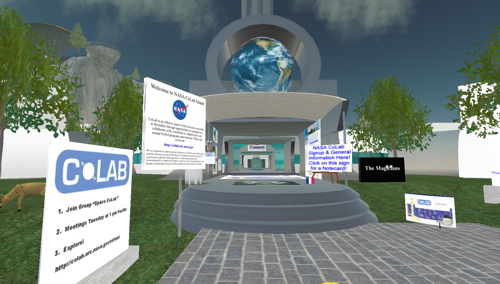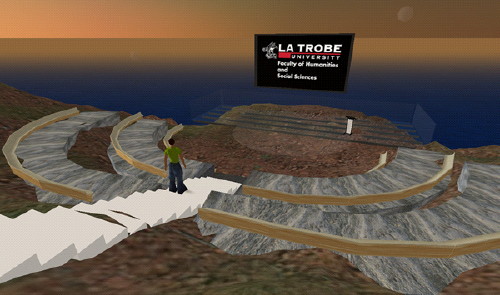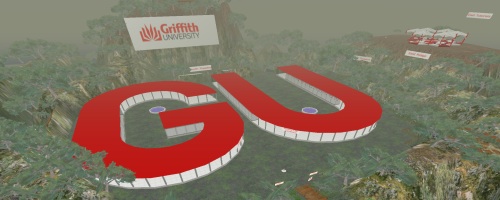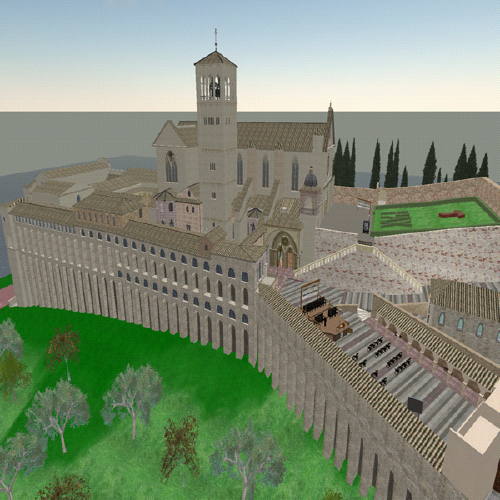Linden Lab today announced the creation of the SLED Blog, a welcome evolution from the busy SLED email list. Education is certainly one of Second Life’s strong points and a well maintained blog will help this along further.
Starfighters Wanted: Apply @ NASA
Back in 1984 there was science fiction adventure movie called The Last Starfighter. The storyline involved Alex, a teenage boy, hitting the top-score on a video game which turns out to be a recruitment device for the League (the goodies) who are doing battle with the Xur and Kodan (the baddies).
Even before 1984 various science fiction styled games have developed, along with the technology. Games such as World of Warcraft, Halo and Quake are today’s better known ones, much to the dismay of parents and some spouses, no doubt.

Where does NASA fit in on this?
Game developers have until February 15 to submit their ideas for a “Massively Multiplayer Online (MMO) Learning Game” that promotes the delivery of “NASA relevant content through innovative applications of technologies to enhance education”.
The intent by NASA appears to be to build a stand-alone virtual world that could act as a meaningful “hands-on” tool supporting education in “…a range of complex subjects, including science, technology, engineering and mathematics (STEM) based instruction”.
A quick search of the internet shows that NASA has quite a few traditional website based education and information areas but in the realm of alternative realities there is only a passing mention. For example, their area in Second Life: NASA Colab Island.
NASA’s call for submissions to build an MMO will be interesting in both the gaming aspect of the project and its intended education focus as it joins a growing number of private and governmental organisations that are establishing either game or virtual world presence for the express purpose of education and training.
Coupled with the recent publicised findings that surgeons in training benefit from using Wii suggests the convergence between online lives and education would appear to be a given, if not a virtual reality.
Education & Non-Profit Organisations in Second Life
One of the problems we encounter in this information age is the enormous quantity of information encountered each day and the danger of overlooking the bleeding obvious.
Checking out the home page of Second Life every now and then to see what is happening can throw up some interesting gems. If you’re like me that may be every blue moon, but this week I happened to notice over in the right side margin an item labelled; “Education & Non-Profit Organizations“.

A perusal of this link will show there is an enormous wealth of information, web and SL based resources for those interested in either setting up an educational or non profit presence in SL. Or for those looking into the opportunities that SL offers in various educational areas.
At the educational level a click on the More… link towards the bottom of the page opens the wiki listing a pretty full list of universities and other education providers in SL.
A quick scan down the list shows that the “Australian Film TV and Radio School: Sydney, Australia” but no others from our neck of the woods. Perhaps its time for someone from the Australian Universities we have featured here on SLOz to pay a visit and add their details…
La Trobe University Island
Since July, another Australian university has been developing a presence in SL – La Trobe University. As others have done, La Trobe has chosen to purchase an island and it is a quite dramatic build with a coastal plains style area at the teleport point and soaring ridges behind.
The current main lecture theatre is called The Moat and not too far away, nestled in a small valley, are the under construction “Social Areas”.

This is still a work in progress, a key and important element we have noted in a recent post on Australian universities developing presences in SL.
Of special interest is the faculty that is driving this particular SL presence – the Faculty of Humanities and Social Sciences. The diversity of faculties that underpin SL builds by Australian universities is especially heartening as it highlights, to some degree, the use of Web 2.0 technologies being explored beyond computer science courses.
The person to contact in-world is Flossy McMahon, (Dr Kay Souter), Associate Dean (Learning and Teaching) of the Faculty of Humanities and Social Sciences. Doubtless we will see some interesting teaching and learning developments.
The “Eavesdrop School of Languages” Approach
As indicated on Saturday night’s posting, the interest in the use of voice technology is being canvassed. There has been a recent flurry of activity by educators interested in using the voice and audio ability of SL to enhance lessons in learning a foreign language. The approach to learning languages seems to take the form of eavesdropping in areas and cityscapes from various regions around the world.
This approach could have some interesting ethical and pedagogical issues. It would seem to be university language courses that are utilising the idea of organising field trips to various cityscapes and “eavesdropping” on inhabitants going about their daily business in their native tongue.
What would prove interesting is if private language colleges and teachers started to offer guided experiences in this way.
To this end I paid a visit to one popular area for those interested in learning Italian. That of Mantova – Italia – Italy.
Being in Australia you need to check the relevant timezones so as to encounter people in this area. But, at the time I was there a number of people dropped in and used the SL talk option. The quality and clarity of sound was quite good and I can see how this method could be a major resource for immersing learners in relevant language lessons and experiences.
For those interested in finding out more about language learning in SL you may like to take part in the Festival of European Languages, September 26 on Belle Isle.

Belle Isle Europe Map with Landmark posts for various cityscapes and areas for “eavesdropping” on native languages for that particular country.
From the information sheet provided by the organisers:
8am SLT (4pm London) Welcoming
9am/5pm Russian/Baltic states/Finnish
10am/6pm Eastern Europe/Greek
11am/7pm Italian/German/Scandinavian
12 noon/8pm French/Belgian/Dutch/
1pm/9pm English/Spanish/Portuguese
SL Education vs Personal Beliefs
We have been tracking the growing number of educational facilities setting up presences in SL. Many have been active in setting up and conducting both courses and specific lectures in-world.
A recent email list posting amongst SL educators raised the issue of a student declining participation in the SL portion of coursework due to “personal beliefs”. The ongoing thread has covered a number of possible scenarios and reasons behind such a refusal and this may be a good thing given recent postings here about under-age content and use of “mature” areas when setting up a presence as an education provider.
Given the emergence of SL as an exciting and different medium for the delivery of courses and syllabus content the issue of not being penalised for refusing to participate in in-world coursework is a new and never before encountered tension that educators may have to deal with in a formal policy manner.
It has been discussed amongst educators that both strict Islamic and conservative Christian students object to graphic representations of the human body. As one educator stated, “In this case, SL would certainly be a religious problem.”
For SL based course-work it may mean requirign strict body and clothing forms for students when participating and locked areas for course particpants only.
A wander through either the Australian or Foreign Universities currently engaged in SL has shown most people in casual dress. But if a student were to choose the form of a furry or other such form, would it distract from the lecture, offend other students or in some way draw a code of conduct indiscretion under SL or the University’s guidelines?
Then again, maybe the term “hippy” may need to be rephrased to encompass fippies (furry), aippy (age-play form) or mippy (monster style students).



Recent Comments